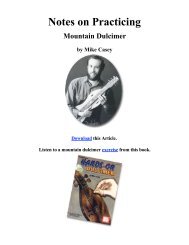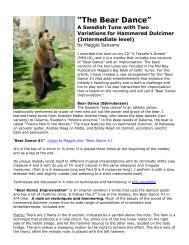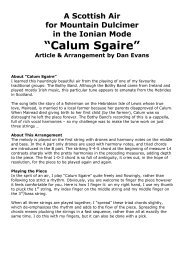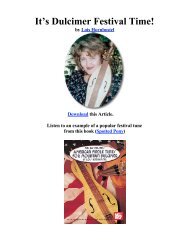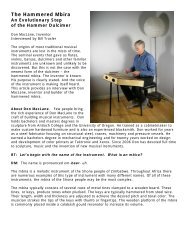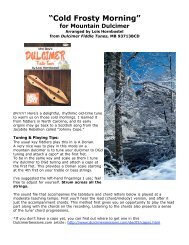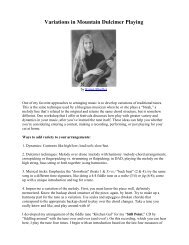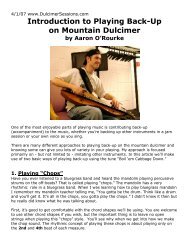Touring Turlough O'Carolan Country and Playing - Mel Bay's ...
Touring Turlough O'Carolan Country and Playing - Mel Bay's ...
Touring Turlough O'Carolan Country and Playing - Mel Bay's ...
You also want an ePaper? Increase the reach of your titles
YUMPU automatically turns print PDFs into web optimized ePapers that Google loves.
<strong>Touring</strong> <strong>Turlough</strong> O’Carolan <strong>Country</strong> <strong>and</strong> <strong>Playing</strong><br />
“Carolan’s Receipt” on Hammered Dulcimer<br />
by Jeanne Page<br />
It is fitting that I pay special tribute to Irish harper/<br />
composer/poet/singer <strong>Turlough</strong> O’Carolan, for he was<br />
“instrumental” in leading me into the hammered dulcimer<br />
world. Many years ago I was given a mountain dulcimer as<br />
a gift. Not long after, I providentially found a copy of a<br />
dulcimer recording by Joemy Wilson: “Carolan’s Cottage.” I<br />
popped the cassette into my player <strong>and</strong> sat in a trance. I<br />
was unaware that there were two kinds of dulcimers, <strong>and</strong><br />
since there was no photo of the instrument on the cover, I<br />
was completely taken by surprise with the bell-like quality<br />
of these magical strings. As I soaked up the rich melodies,<br />
I became enchanted with the O’Carolan tunes dancing on<br />
air, <strong>and</strong> with the instrument producing such mesmerizing<br />
tones. I knew that those sounds couldn’t be produced by<br />
the dulcimer in my lap. It had to be something different! I<br />
didn’t know what that instrument looked like, or how to play<br />
one—I just knew that I had to have one! It wasn’t long before I had purchased my first<br />
hammered dulcimer <strong>and</strong> I began playing my first O’Carolan tune, “Planxty George Brabazon.”<br />
Years later when my husb<strong>and</strong> <strong>and</strong> I finally journeyed across the pond for a visit to the<br />
Emerald Isle, I knew that touring <strong>Turlough</strong> O’Carolan country would be high on the sightseeing<br />
priority list. By that time I had long since taken up the harp as well, <strong>and</strong> my connection<br />
with Carolan had deepened as a result.<br />
We began our O’Carolan portion of the trip in County<br />
Roscommon in the western inl<strong>and</strong>s of the Republic of<br />
Irel<strong>and</strong>. Our first stop was the tiny town of Keadue<br />
(Ceideadh in Gaelic, translated ‘low lying hill’) that, in<br />
addition to winning the National Title in the “Tidiest Town”<br />
competition, is also the home of the annual O’Carolan<br />
International Harp Festival. Each August musicians from<br />
all over the world descend on this delightful village to pay<br />
homage to Irel<strong>and</strong>’s favorite bard with concerts,<br />
sessions, workshops, recitals, <strong>and</strong> the International<br />
O’Carolan Harp Competition. Ten days are devoted to<br />
everything O’Carolan.<br />
It is in this picturesque village that we found the<br />
O’Carolan Heritage Park that was opened in 1993.<br />
This pretty little spot in the middle of the town has<br />
flagstone paths, fountains, <strong>and</strong> a bronze replica of<br />
Carolan’s harp as the historical centerpiece. A small<br />
Round House on the grounds also features the music of<br />
his first composition “Sidh Beag, Sidh Mor.” Since this<br />
was our first stop, I immediately jumped out of the rental<br />
car <strong>and</strong> ran up to that bronze statue to count the strings.<br />
Yes, I thought, it looks like it was 36 strings…<strong>and</strong> not<br />
very large either…at least compared to 36 string harps of
today. I ran my h<strong>and</strong>s over that statue so thrilled to see this replica of the actual instrument<br />
he played! After sitting in the little Round House for a bit <strong>and</strong> enjoying a quiet moment, it was<br />
back in the car to hunt down our next appointed l<strong>and</strong>mark.<br />
Our journey took us to the nearby village of Ballyfarnon located at the base of the Arigna<br />
Mountains. The Alderford House in Ballyfarnon was built nearly 400 years ago <strong>and</strong> was owned<br />
by the McDermott Roe family. It was on the grounds of the estate that young <strong>Turlough</strong> lived<br />
as a boy; it is where he was stricken with blindness as a youth; it is where he received his<br />
first harp lessons due to the kindness of Mrs. McDermott Roe, <strong>and</strong> it is where he eventually<br />
died. Carolan composed many tunes honoring members of his first patroness <strong>and</strong> her family.<br />
It is said that at the end of his life, he arrived on her doorstep, quite ill, saying, “I have come<br />
here after all I have gone through to die at home at last, where I got my first schooling, <strong>and</strong><br />
my first horse.” He was immediately taken in <strong>and</strong> tenderly cared for during the week that<br />
preceded his death. Sensing that he was nearing the end, he called for his harp <strong>and</strong> played<br />
his well-known “Carolan’s Farewell to Music.” His former music pupil Charles O’Conor<br />
recorded his passing: “Saturday, the 25th day of March, 1738. <strong>Turlough</strong> O’Carolan, the wise<br />
master <strong>and</strong> chief musician of the whole of Irel<strong>and</strong>, died today <strong>and</strong> was buried in the<br />
O’Duignan’s church of Kilronan, in the sixty-eighth year of his age. May his soul find mercy,<br />
for he was a moral <strong>and</strong> religious man.” His wake lasted for four days <strong>and</strong> it was reported that<br />
harpers <strong>and</strong> musicians from all over Irel<strong>and</strong> assembled, camping out on the grounds<br />
surrounding the mansion. Day <strong>and</strong> night, O’Carolan tunes wafted out across the hills <strong>and</strong><br />
valleys in every direction.<br />
As we drove into Ballyfarnon, we were armed with a few obscure clues that helped us to<br />
locate the Alderford House.<br />
The crumbling iron gate can be seen from the road but most would pass by it without noticing<br />
it, or knowing its historical significance. My husb<strong>and</strong> <strong>and</strong> I parked the car <strong>and</strong> climbed over<br />
the tiny fence.
We walked some distance wondering if the house still existed <strong>and</strong> then suddenly we came<br />
upon it. It was sadly in terrible disrepair.<br />
Like the front gate, the building, too, was crumbling <strong>and</strong> the l<strong>and</strong> surrounding it was over run<br />
with weeds. Old automobiles, tractors <strong>and</strong> junk littered the area <strong>and</strong> I found myself shocked<br />
<strong>and</strong> disappointed that a home with so much musical history would have been left to such a<br />
fate. We walked all around it <strong>and</strong> as I looked up to the broken panes of glass, I imagined a<br />
dying <strong>Turlough</strong> breathing his last in one of those rooms.
As I gazed at the fields of tall grass surrounding the house, I could almost see hundreds of<br />
little campfires each surrounded by fiddlers <strong>and</strong> harpers paying tribute to Irel<strong>and</strong>’s National<br />
Composer. We walked silently back to our vehicle, a bit melancholy over the visit.<br />
A few days after Carolan’s death over 60 different clergymen, a number of wealthy patrons<br />
<strong>and</strong> scores of country friends <strong>and</strong> admirers attended his funeral. His remains can be found<br />
today at the nearby Kilronan Abbey.<br />
After our visit to Alderford House we stopped to pay our respects to the Gr<strong>and</strong> Musician.<br />
Above the entrance to the tiny graveyard, a stone heading declares “Within this Churchyard<br />
lies interred Carolan, the last of the Irish Bards. He died March 25th, 1738. RIP.
We made our way through the sea of Celtic crosses <strong>and</strong> found the stone enclosure. The gate<br />
was open <strong>and</strong> we entered to st<strong>and</strong> quietly at his burial site. We noticed various tokens, such<br />
as coins <strong>and</strong> trinkets left around his grave, <strong>and</strong> one that brought a smile…an empty whiskey<br />
bottle. Those who know Carolan’s history would underst<strong>and</strong> that this silent toast to <strong>Turlough</strong> is<br />
probably the most fitting tribute. It is said that one doctor scolded Carolan for his liquor<br />
consumption <strong>and</strong>, for the sake of his health, ordered him to abstain from that point forward.<br />
This unhappy pronouncement was followed by Carolan’s composition “Farewell to Whiskey.”<br />
Carolan did try to follow the doctor’s orders but found that he felt so much worse by doing so;<br />
he fell into a depression <strong>and</strong> even neglected his music. As chance would have it, he came<br />
across a different physician who provided a “second opinion” <strong>and</strong> advised Carolan to return to<br />
imbibing as usual. The harper was so thrilled that he wrote one of his most famous tunes,<br />
“Carolan’s Receipt,” in honor of that welcomed physician’s prescription. You can find that<br />
tune at the end of this article for your playing pleasure!<br />
After wishing <strong>Turlough</strong> a peaceful rest, we returned to our car <strong>and</strong> headed for the last stop on<br />
our itinerary. I had learned, quite by accident, that upon his death, O’Carolan’s harp had been<br />
bequeathed to the O’Conor family of Connacht—another clan immortalized by the tunes that<br />
he composed in their honor. So we started down another skinny Irish road in search of<br />
Clonalis House in Castlerea. After missing the entrance (more than once) <strong>and</strong> a series of uturns,<br />
we finally found our way to Clonalis House. Since my husb<strong>and</strong>, Shane, has his roots in<br />
O’Conor ancestry we had another reason for seeking out this historical l<strong>and</strong>mark. These<br />
particular family members are direct descendants of Connacht’s traditional ruling dynasty <strong>and</strong><br />
some of Irel<strong>and</strong>’s last High Kings.
When we arrived, we were the only visitors <strong>and</strong> so had a<br />
private tour of the house. The paintings <strong>and</strong> artifacts on<br />
display told a fascinating tale, but I was quite anxious to get<br />
to the room that held my hearts desire! Finally, we turned<br />
the corner of a long hallway <strong>and</strong> there it was…enclosed in<br />
protective glass. <strong>Turlough</strong> O’Carolan’s own harp lay on<br />
its back, a chunk of wood gouged out of the very tip, but<br />
other than that, in remarkably good condition. Our young<br />
guide knew that our visit to Clonalis House was primarily to<br />
see this treasure <strong>and</strong> he was kind enough to let us dawdle<br />
for a very long time. My husb<strong>and</strong> used the opportunity to<br />
pick his brain about more O’Conor history, while I walked round <strong>and</strong> round the harp taking it<br />
in from all angles. Oh how I longed to break open that box <strong>and</strong> take it in my arms, pluck a<br />
string or two <strong>and</strong> caress the wood with my h<strong>and</strong>s. I allowed my imagination to run wild <strong>and</strong> I<br />
envisioned myself cradling the harp for a few moments, protecting it, while <strong>Turlough</strong> helped<br />
himself to a shot of whiskey. He would return, thank me for keeping watch over it, <strong>and</strong> then<br />
begin playing “Planxty Fanny Power” for the enjoyment of all in the room. I would sit in<br />
raptured silence, marveling at this man’s gift of melody. It was hard to tear myself from that<br />
room, especially since our guide was so willing to let me enjoy the moment, but I knew that it<br />
was at last, time to bring our O’Carolan adventure to an end.<br />
As we completed our tour of <strong>Turlough</strong> O’Carolan country <strong>and</strong> headed out of County<br />
Roscommon I was glad to have seen first h<strong>and</strong> a bit of musical history. And I knew it was<br />
only a matter of time before I’d return to do it all again!
& #<br />
4<br />
8<br />
& # G<br />
œ. œ<br />
c œ<br />
. œ œ œ œ œ œ œ<br />
C D<br />
œ<br />
1.<br />
œ œ œ œ œ<br />
G<br />
œ œ œ œ œ œ œ<br />
2.<br />
20<br />
C G<br />
œ œ. œ œ<br />
œ. œ<br />
Em Bm<br />
œ œ œ œ œ œ<br />
& # G<br />
C G<br />
C G<br />
œ. œ<br />
œ œ œ œ . œ œ œ œ œ œ . œ œ œ œ œ œ œ œ<br />
& #<br />
12<br />
& #<br />
16<br />
& #<br />
20<br />
24<br />
œ œ œ œ œ œ œ ˙ œ. J œ<br />
C<br />
C Bm<br />
œ œ œ œ œ œ œ œ<br />
C<br />
œ œ œ œ œ œ œ œ<br />
D<br />
Carolan’s Receipt<br />
C<br />
˙ œ œ œ<br />
Em D<br />
œ œ œ œ ˙<br />
1.<br />
C G<br />
G Am<br />
œ œœ œ œ œ œ œ<br />
G D<br />
œ œ œ œ œ œ œ œ<br />
œ œ œ œ<br />
œ<br />
œ<br />
œ<br />
G D G C<br />
& # œ œ œ œ œ œ œ .<br />
œ œ œ œ œ œ œ<br />
œ œ œ œ œ œ œ œ<br />
Em D<br />
œ œ œ œ œ œ œ œ<br />
C G<br />
œ œ œ œ œ œ œ<br />
Bm C G<br />
œ œ œ œ œ.<br />
J œ<br />
Em G<br />
œ œ œ œ œ œ œ œ<br />
G Em<br />
œ œ œ œ .<br />
œ<br />
2.<br />
C G<br />
œ œ œ œ<br />
O’ Carolan<br />
j<br />
œ
& #<br />
4<br />
8<br />
& # G<br />
œ. œ<br />
c œ<br />
. œ<br />
œ œ œ œ œ œ œ<br />
C D<br />
œ œ œ œ œ œ<br />
1.<br />
G<br />
œ œ œ œ œ œ<br />
2.<br />
œ œ<br />
21<br />
C G<br />
œ<br />
œ<br />
.<br />
œ œ œ œ<br />
Em Bm<br />
œ. œ<br />
œ œ œ œ œ<br />
& # C G<br />
C G<br />
œ. œ<br />
. .<br />
œ<br />
œ œ œ œ<br />
œ œ œ œ œ œ œ<br />
œ<br />
œ G<br />
œ œ œ œ œ<br />
& #<br />
12<br />
& #<br />
16<br />
& #<br />
20<br />
24<br />
œ œ œ œ œ œ œ œ ˙<br />
C Bm<br />
œ œ œ œ œ œ œ œ<br />
C<br />
œ œ œ œ œ œ œ œ<br />
D<br />
Carolan’s Receipt<br />
C<br />
C<br />
˙<br />
œ. J œ<br />
œ œ œ<br />
Em D<br />
œ œ œ œ ˙<br />
G Am<br />
œ<br />
1.<br />
C G<br />
œ œ œ œ œ œ œ<br />
œ œ œ œ œ œ G D<br />
œ œ<br />
œ œ œ œ<br />
œ<br />
œ<br />
œ<br />
G D G C<br />
& # œ œ œ œ .<br />
œ œ œ œ œ<br />
œ œ œ œ<br />
œ<br />
œ œ œ œ œ œ œ œ<br />
Em D<br />
œ œ œ œ œ œ œ œ œ<br />
C G<br />
œ œ œ œ œ œ<br />
Bm C G<br />
œ<br />
Em G<br />
œ œ<br />
œ œ œ œ.<br />
œ. J œ<br />
œ œ œ œ œ œ œ œ œ<br />
G Em<br />
œ œ œ œ .<br />
œ<br />
2.<br />
C G<br />
œ<br />
œ œ œ<br />
O’ Carolan<br />
j<br />
œ
About the Author<br />
Jeanne Page is a native of Albuquerque, New Mexico. She began her lifelong journey into folk<br />
music at age 12, singing <strong>and</strong> playing the guitar. Since then, she has gravitated to focus<br />
primarily on the hammered dulcimer <strong>and</strong> Celtic harp. She teaches both instruments privately<br />
<strong>and</strong> through the University of New Mexico. Jeanne is the director of a youth harp ensemble<br />
called the "Apple Mountain Harp Kids," <strong>and</strong> co-founded with her husb<strong>and</strong>, Shane, the Apple<br />
Mountain Dulcimer Club <strong>and</strong> the Apple Mountain Harp Circle. She also directs the "Harps in<br />
Healing Service Program" in Albuquerque, New Mexico. Jeanne has been performing solo <strong>and</strong><br />
with the Celtic/Folk b<strong>and</strong> "Heirlooms" since 1992, <strong>and</strong> has several instructional books<br />
available through <strong>Mel</strong> Bay Publications:<br />
. Arranging for Hammered Dulcimer, MB98121<br />
. Hammered Dulcimer Chords, MB96675<br />
. Scottish Songbook for Hammered Dulcimer, MB99712<br />
. Tis the Season: Hammered Dulcimer Collection, MB20806<br />
. With This Ring: A Hammered Dulcimer Collection for Weddings <strong>and</strong> Special Occasions,<br />
MB20805<br />
You can learn more about Jeanne <strong>and</strong> her recordings <strong>and</strong> publications at<br />
www.thenextchapter.net or jeannepage@comcast.net. Visit her MySpace at:<br />
http://profile.myspace.com/index.cfm?fuseaction=user.viewprofile&friendID=216168510



